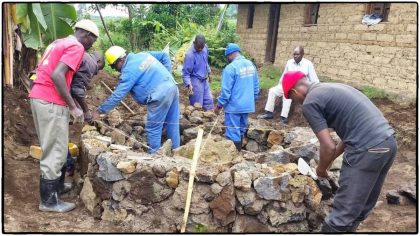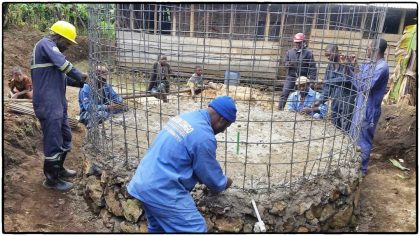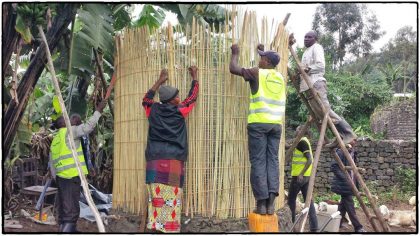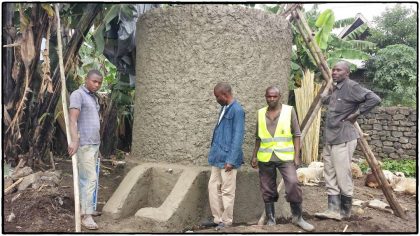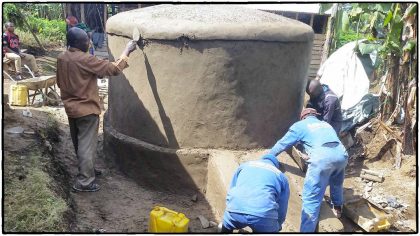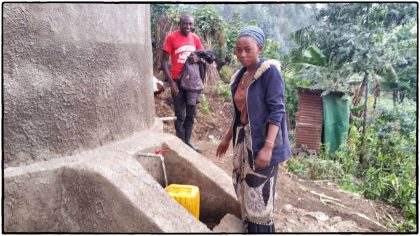8 Rainwater Catchment Systems and 20,000 Liter Ferro-Cement Water Tanks for the Kibumba Region of Congo!
Kibumba, Democratic Republic of Congo
Kibumba, DRC is located in the North Kivu province within the Nyiragongo territory. It sits between the border of Rwanda and Virunga National Park. The recent history of the area has been dominated by the active Nyiragongo volcano and the Rwandan Genocide of 1994 which in turn fueled the First and Second Congo Wars. The aftermath of these events was still having effects on the capital city of Goma and its surroundings in 2010. The city of Goma was captured by rebels during the M23 rebellion in late 2012 but has since experienced peace and some prosperity.
The 30,000 people who make up Kibumba have experienced displacement more than 4 times over the last decade. However, they are now re-establishing their farms and their communities. Access to water is a desperate need as there are no rivers or wells for people to access. Community members have resorted to making the 6-hour, 12 km, round-trip trek into Rwanda to access water. Because of the political climate, the border is often closed leading many to travel 30 km into Goma for water.
The easiest way for community members to access water is to catch runoff rainwater from rooftops or to venture into Virunga National Park. During the dry season, collecting water from rooftops are not an option, and entering into Virunga National Park is dangerous to those trying to enter into the protected area and a threat to the wildlife that inhabits the park.
A Proven Method
The Kibumba water catchment is phase two of our Kibumba project. Phase one involved the establishment of a water committee and brought clean water to the entire community of 5,000 households totaling 30,000 people, by training and distributing 5,000 Sawyer filters to every home. Those filters eliminated sickness and diseases like cholera, typhoid, worms, etc. and moved the entire community to health. That same local water committee that oversaw the filter phase is now overseeing the building of rain catchment systems. They have well trained local workers and managers who can build and complete a 20,000 liter, 50-year rain catchment system in one week.
Water is Basic has been working with ALARM-DRC for two years on building a local team of well trained capable builders. We piloted this project by building five 5,000-liter tanks and then expanded to 20,000-liter tanks. The cost per liter is much better at the 20,000 level. We sent our team to Rwanda for extra training in building large tanks and are now building exclusively 20,000 liters tanks. They have completed 25.
Immediate Objective
The overall goal of this plan is to provide enough water storage for the Kibumba community to make it through the 4-month dry season. To meet the need of the population, the committee’s plan is to build 500 rain catchment systems serving the entire population of Kibumba.
The overall expected benefits include:
1. Reduction of poverty and financial burdens for community members who pay up to 500-1000 Congolese Francs (0.32-0.64 USD) for one 20-liter jerry can.
2. Reduction in the number of people in Kibumba suffering from illnesses related to drinking unsafe water.
3. Reduction in time spent on fetching water for girls and women.
4. Increased number of girls who can go to school, thus minimizing risks of poor outcomes associated with lack of primary education (e.g., illiteracy, human tracking, and contracting STDs).
5. Increased number of women who can work (outside of the home) and contribute to the family’s financial stability.
6. Decreased health problems for girls and women related to carrying jerry cans for long distances.
7. Elimination of conflict and violence from disputes over water.
8. Improved economic stability for the region with agricultural opportunities for Kibumba.
9. Elimination of the threat of danger to those entering the protected area of Kibumba National Park.
10. Preservation of Kibumba National Park by eliminating the need for outsiders desperate for water to enter into the park.
*Attached you will find a report prepared by Bonhuer Amani, the Kibumba project coordinator.
Along with Beatrice, a local leader and engineer, they interview community members who are beneficiaries of each rain catchment system. Bonhuer provides excellent reporting with weekly updates and monthly reports. With an experienced team in place, they are ready to continue with more projects and have proven that they can successfully construct the rain catchment systems train the local community members and follow up with excellent reporting.
I. Introduction
The activities done this week were to install (gutters and taps) on two Rainwater catchments at Buhumba. On Wednesday, we started building two more Rainwater catchments at Kibumba.
II. Activities done
The two Rainwater catchments under building will be managed by Mrs. Françoise Chui and Mr. Maniteze Rwajekare.
Mrs. Françoise Chui, 38 years old, mother of 5 children, married to Safari
Françoise is a farmer and takes care of her household because her Husband is always out of Kibumba. She also sells some local vegetable products which helps them to pay school fees for their children and respond to other needs.
About the Rain Water catchment, she said, “At Kibumba, women are more concerned by water problems because traditionally it’s our job. Following the water problem, this makes us very tired. That’s why we thank you very much for the Rainwater catchments you are building us. This one will help me a lot and help my neighbors because we always share water. Finally, our children will not walk kilometers to fetch water. May God bless you infinitely.
Mr. Maniteze Rwajekare, 72 years old, father of 7 children
Mr Maniteze Rwajekare is Anuarité Maniriho’s Husband. They have seven children and all are farmers.
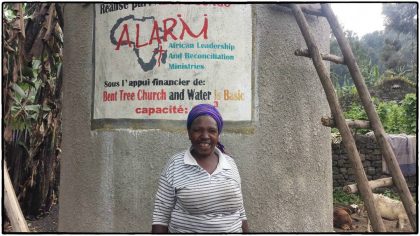
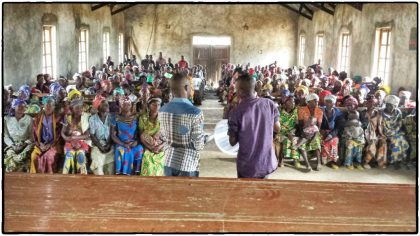
Due to the Rain Water catchment underbuilding, he says, “I thank ALARM-Congo and its partners for this help. Due to filters already received, waterborne diseases have decreased, children are healthy and they study properly. About the rainwater catchment 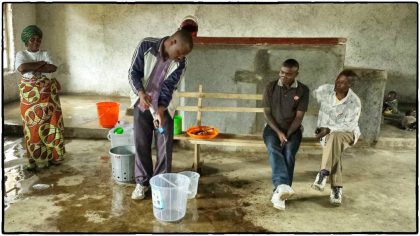 underbuilding today, we are proud of it and grateful of its benefits. We are going to protect it because it will help us to us to solve our water problem. Thank you very much and may God bless you”.
underbuilding today, we are proud of it and grateful of its benefits. We are going to protect it because it will help us to us to solve our water problem. Thank you very much and may God bless you”.
On behalf of the team,
Bonhuer
